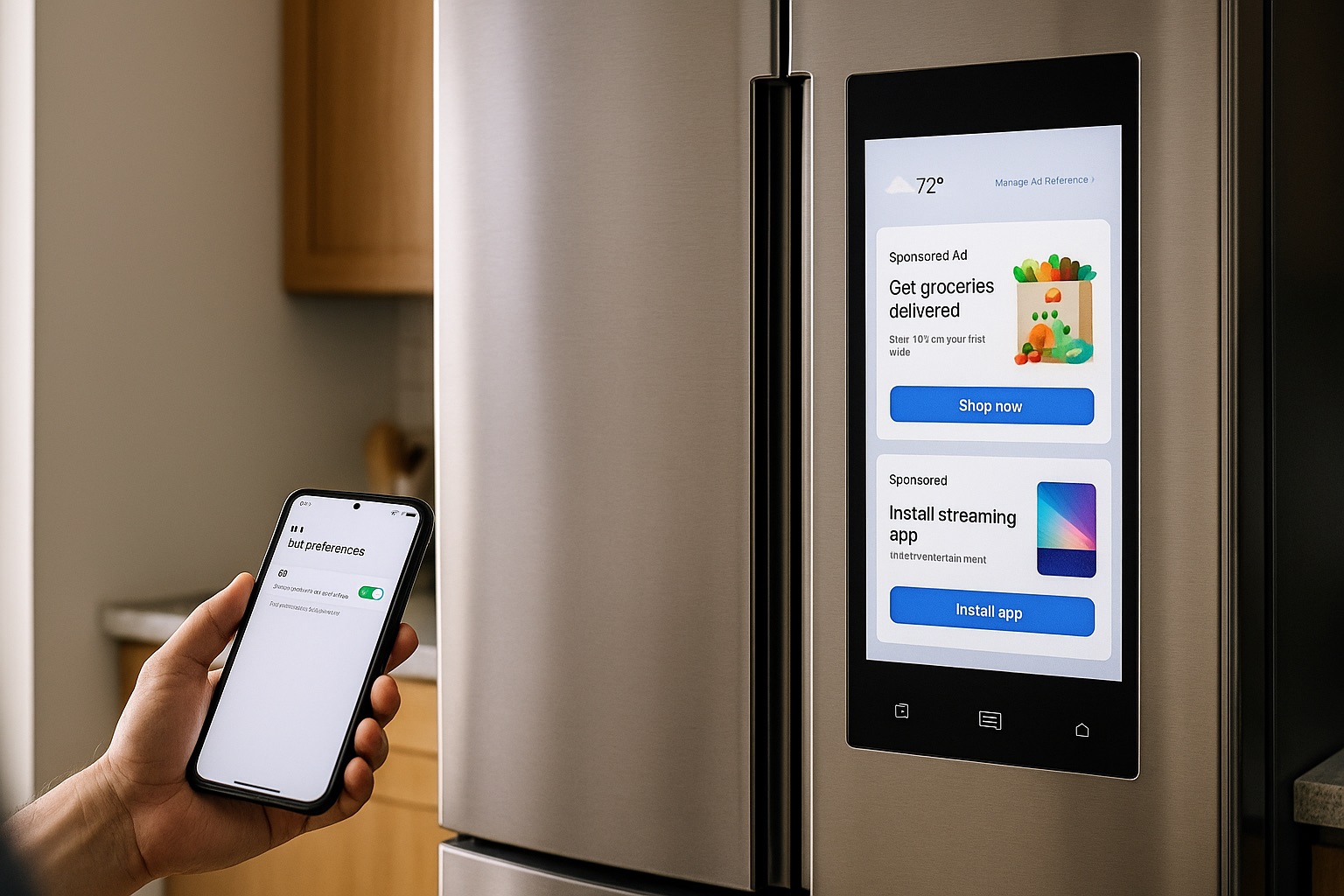Samsung just pulled a classic tech company move that’ll make you question everything about “smart” appliances. After telling The Verge in April that they had “no plans” to put ads on their Family Hub refrigerators, guess what’s rolling out in a software update right now? Yep, advertisements are coming to your kitchen’s most expensive appliance, whether you want them or not.
The company is calling this a “pilot program” designed to “strengthen the value” of owning a Samsung smart fridge. That’s like saying billboards strengthen the value of your morning commute—technically true if you enjoy being marketed to while grabbing milk, but probably not what you had in mind when you dropped several thousand dollars on a premium appliance.
This represents something bigger than just annoying ads on your fridge. It’s about how tech companies view the devices you own and whether “smart” features come with hidden costs that only reveal themselves later.
What Samsung’s “Value-Adding” Ads Actually Look Like
Samsung’s marketing team worked overtime to make this sound beneficial. According to their official statement, these “promotions and curated advertisements” will appear on Family Hub refrigerator Cover Screens—that’s the display you see when your fridge screen is sitting idle.
How the ad system works:
- Ads appear only when the Cover Screen is idle (not actively being used)
- You can dismiss specific ads so they won’t appear again during that campaign
- No ads during Art Mode or when displaying photo albums
- Ad formats may change based on your Cover Screen personalization settings
- Everything comes via over-the-network software updates
Think of it like having a digital billboard that occasionally takes over your fridge’s interface. The good news is Samsung isn’t completely hijacking the experience—you can still use Art Mode or family photos without interruption. The less good news is that your premium kitchen appliance now comes with commercial breaks.
The dismissal feature offers some user control, but it’s worth noting you’re dismissing individual ads, not the advertising system entirely. Once a campaign ends, new ads will appear, and the cycle continues.
From “No Plans” to Pilot Program: How We Got Here
Back in April, Samsung explicitly told The Verge they had “no plans” to put ads on Family Hub refrigerators. Fast-forward to now, and suddenly there’s a pilot program launching across US market fridges. That’s either remarkably fast product development or a communications strategy that wasn’t entirely forthcoming.
Samsung’s official justification: “Samsung is committed to innovation and enhancing every day value for our home appliance customers. As part of our ongoing efforts to strengthen that value, we are conducting a pilot program…”
Translation: We found a way to generate additional revenue from devices you’ve already purchased, and we’re framing it as a customer benefit.
The “pilot program” framing suggests Samsung is testing user reaction and advertiser interest before making this permanent. Your response to these ads—whether you tolerate them, complain loudly, or dismiss them consistently—likely influences whether this becomes standard across all Samsung smart appliances.
Samsung’s Pattern: Smart TVs Were Just the Beginning
Samsung didn’t stumble into appliance advertising accidentally. The company started putting ads on smart TVs back in 2016, establishing a clear pattern of monetizing device interfaces after purchase. The Family Hub refrigerator ads represent an expansion of this strategy into kitchen appliances.
Samsung’s “screens everywhere” initiative includes:
- Smart TV advertising (since 2016)
- Family Hub refrigerator displays
- Various other connected home appliances with screens
- Potential future expansion to additional smart home devices
This progression makes sense from Samsung’s business perspective. Every screen represents potential advertising inventory, and smart appliances stay in homes for years, creating long-term revenue opportunities beyond the initial device sale.
What this means for other smart appliance makers: If Samsung’s pilot program proves successful, expect other manufacturers to explore similar advertising integration. LG, Whirlpool, and other appliance companies are watching these results closely.
User Control vs Corporate Revenue: What You Can Actually Do
Samsung provides some user controls, but they’re designed to manage ad experience rather than eliminate advertising entirely. Understanding these options helps you minimize disruption while using your Family Hub refrigerator.
Available user controls:
- Dismiss individual ads to prevent repeat appearances during campaigns
- Use Art Mode to avoid ads entirely during that display mode
- Display personal photo albums instead of Cover Screen advertising
- Adjust Cover Screen personalization settings to influence ad formats
What you cannot do:
- Completely disable the advertising system
- Opt out of future ad campaigns
- Remove advertising functionality without potentially voiding warranty
- Prevent Samsung from adding more advertising features via software updates
The Terms of Service update that accompanies these ads likely includes language protecting Samsung’s right to display advertisements and modify the advertising experience. Reading these updated terms reveals what rights you’re agreeing to regarding your appliance’s interface.
Smart Appliance Reality Check: What “Connected” Really Costs
Samsung’s refrigerator ads highlight a broader issue with smart appliances: ongoing connectivity enables ongoing monetization that wasn’t clearly communicated at purchase time. Your “smart” fridge isn’t just smart for your convenience—it’s smart enough to generate revenue for Samsung indefinitely.
Hidden costs of smart appliance connectivity:
- Advertising integration that arrives via software updates
- Data collection about usage patterns and preferences
- Potential subscription requirements for premium features
- Ongoing software dependency that could affect functionality
- Corporate policy changes that modify your device experience
Traditional appliances vs smart appliances: Your old refrigerator worked the same way for 15 years because it couldn’t be updated remotely. Smart appliances can be modified, monetized, and potentially degraded through software changes you cannot prevent.
The ownership question: When Samsung can change your refrigerator’s interface, add advertising, and modify functionality through mandatory updates, what does “owning” the appliance actually mean?
What This Means for Future Smart Home Purchases
Samsung’s advertising expansion offers valuable lessons for anyone considering smart appliances or connected home devices. The initial purchase price may not reflect the complete cost of ownership when companies can monetize your attention indefinitely.
Questions to ask before buying smart appliances:
- Can the manufacturer add advertising via software updates?
- What data collection policies govern the device’s connectivity?
- Are essential features dependent on ongoing internet connectivity?
- How does the company’s privacy policy address future changes?
- What happens if you refuse software updates or disconnect from the internet?
Alternative approaches:
- Consider “dumb” appliances that perform core functions without connectivity
- Research companies with explicit no-advertising policies for connected devices
- Factor potential advertising annoyance into your purchase decision
- Understand that premium pricing doesn’t guarantee ad-free experiences
Samsung’s Family Hub advertising represents a larger shift in how technology companies view connected devices—not as products you own, but as platforms they can continuously monetize. Your response to these ads, and similar initiatives from other companies, will determine whether this becomes the new normal for smart home devices.




Post a comment